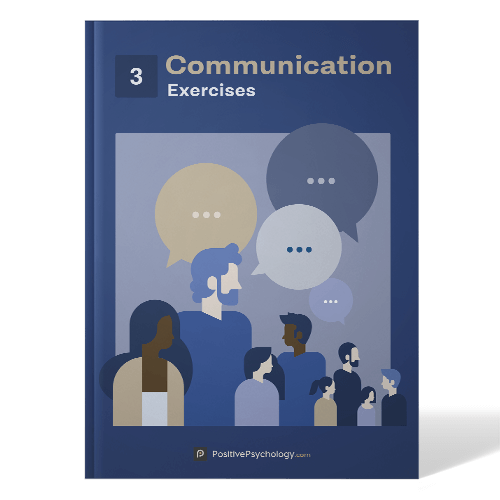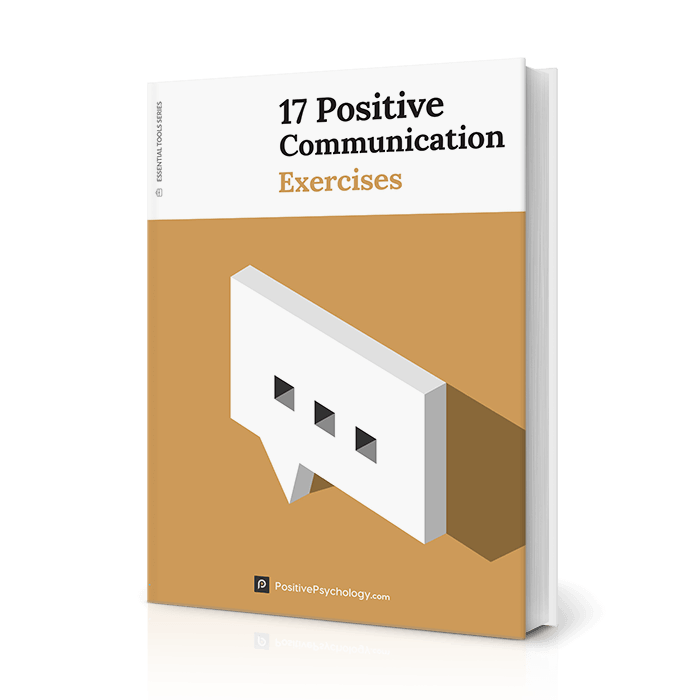7 Ways to Improve Communication in Relationships
 We love connecting with other people because it makes us happy—good communication is the key when it comes to positive social interaction.
We love connecting with other people because it makes us happy—good communication is the key when it comes to positive social interaction.
But what does a healthy conversation look like? How can you avoid over-communicating? And how can you improve communication in a romantic relationship?
Read on for a summary of some important models and theories in the field of communication.
Before you continue, we thought you might like to download our three Positive Communication Exercises (PDF) for free. These science-based tools will help you and those you work with build better social skills and better connect with others.
This Article Contains:
- The Importance of Communication
- What Is Healthy Communication?
- What to Do If There’s No Communication in a Relationship
- How to Better Communicate in Personal Relationships
- How to Improve Communication in Romantic Relationships
- Communication in Long Distance Relationships
- How to Spot Defensive Communication (And Non-Verbal Signs)
- Avoiding Over-Communication
- Books on Communication in Relationships
- Quotes on Communication in Relationships Quotes
- A Take-Home Message
- References
The Importance of Communication
We all have a strong need for connectivity and belonging. This is why positive social interactions increase our subjective wellbeing and provide greater life satisfaction (Lyubomirsky, 2008).
“It is the encounters with people that make life worth living.”
Guy de Maupassant
Nursing social relationships enhance happiness because spending time with friends or colleagues builds positive emotions—a key component of happiness (Fredrickson & Joiner, 2002).
Interactions with people can be verbal or nonverbal—we can even connect with each other through a smile. A vital element of positive social interaction, however, is good communication. But what does that signify?
What Is Healthy Communication?

It also includes feedback, the response of the receiver to the message, as well as noise, which is anything that can disrupt communication.
Encoding refers to the sender transforming thoughts into communicable messages. The receiver interprets what they receive as the message—both verbal and nonverbal parts. Although this seems simple in theory, as you can imagine a lot happens in between and no message is ever decoded without bias.
The way we decode a message is never the objective reality. We all have our own filters and explanatory styles which create the picture of the world as we see it.
What makes the process of communication even more complex is the fact that the message of the sender is hardly ever just factual information.
“We speak not only to tell other people what we think, but to tell ourselves what we think. Speech is a part of thought.”
Oliver Sacks
In his Four-Sides model of communication, Friedemann Schulz von Thun (1981) points out that every message has four facets to it:
- Fact: What I inform about (data, facts, statements);
- Self-revealing: What I reveal about myself (information about the sender);
- Relationship: What I think about you (information about how we get along);
- Appeal: What I want to make you do (an attempt to influence the receiver).
There is never the same emphasis put on each of the four facets, and the emphasis can be meant and understood differently. For instance, a wife saying “the sugar jar is empty” may be less about the fact that there is no sugar left in the jar and more a prompt for her husband to go and fill the jar.
To make it even more complex, as a receiver we tend to have one of the four “ears” particularly well trained (factual ear, relationship ear, self-revelation ear or appeal ear).
So if the husband has a well-trained relationship ear, he may decode the sentence to be something like “you are unreliable since you have forgotten to refill the sugar jar,” and he might retort with something like, “Well you are not very reliable, you still haven’t fixed the light in the kitchen!”
Do you recognize this type of conversation? Things unravel quickly when we are not hearing each other.
The underlying emphasis of both the sender and the receiver on the four facets can create a barrier to healthy communication. It is important to understand that what we hear may not be what the other person was trying to get across.
Think about it: which one is your best developed “ear”? For instance, do you tend to hear an appeal in every sentence? Or do you often feel questioned (hence you are listening with your relationship “ear”)?
In order to engage in healthy communication, we need to be aware of the four facets. So the next time you feel questioned, go back to the original statement and think about the four facets. How else could you have interpreted the message? Focus on the actual facts of the message and use questions to clarify whether you understood what the other person was trying to tell you.
For some more information on the theory and some examples watch this 3-minute video:
What to Do If There’s No Communication in a Relationship
One of the most important communication skills is listening. Deep, positive relationships can only be developed by listening to each other (Weger, Castle, & Emmett, 2010). If there is no communication in your relationship, maybe neither party is truly listening; instead, are both people just trying to prove they are right, or maybe listen while “doing something else” too?
You cannot truly listen to anyone and do anything else at the same time.
M. Scott Peck
Here are the most common listening mistakes:
- Daydreaming or thinking of something else (even something as simple as your list of groceries) while another person is speaking;
- Thinking of what to say next;
- Judging what the other person is saying;
- Listening with a specific goal/outcome in mind.
But active listening is so much more than not talking. It is an art that requires a genuine interest in the other person, a curiosity rather than an anticipative mind. Active listening involves:
- Nonverbal involvement (show your attention)
- Paying attention to your vis-à-vis, not your own thoughts
- No judgment
- Tolerating silence
To revive communication in a relationship try the following exercise: Person A gets 10 minutes to talk about their day, while person B is listening actively and with a genuine interest. Person B is allowed to ask clarifying questions but should not interrupt person A.
If there is a silence that’s fine. Relax.
After person A’s 10 minutes are up (all of the allotted time needs to be used), person B gets to talk for ten minutes as well, while the same listening rules apply to person A. You will find that 10 minutes is a very long time to listen.
You may be amazed at how much you learn about each other, and how this exercise adds value to the quality of your relationship and your communication. It could be something you try once a week, as an intentional way to practice active listening together.
Here are some additional techniques to improve communication in personal and intimate relationships.
How to Better Communicate in Personal Relationships
A great technique to improve communication in any personal relationship is Marshall B. Rosenberg’s nonviolent communication.
It is based on the willingness and the ability to approach and perceive issues in a non-judgmental way. This is important because whenever you want to change someone, you will create resistance.
This technique is great to discuss an issue that is on your mind. For instance, your partner arrives late for your date and you feel angry and disappointed.
For a positive outcome of the conversation follow these four steps:
1. Observation ≠ Interpretation/Evaluation
Firstly, try to communicate your observations without labeling or interpreting them. In the case of your date arriving late, it is just that: he is late.
Your interpretation may be that the date (or you) doesn’t mean a great deal to him or that something else was more important.
So rather than buying into your interpretation, you could simply say “I realize you were late for our date”. This is a factual observation without any evaluation.
2. Feelings ≠ Thoughts
Secondly, it is important that you communicate your feelings. An argument often develops from hidden emotions. Make sure you understand your emotions and express them in a non-judgmental way.
In the case of a late arrival of your date, you could say “I am feeling annoyed”, or “I am bothered by this because it makes me wonder whether you are looking forward to spending time with me”.
3. Need ≠ Strategy

4. Request ≠ Demand
The fourth step is to make a clear request. What does your partner have to do for you to feel that your needs have been met? You could simply say: “That is why I ask you to arrive at the agreed time”.
The four-step process is, as Rosenberg (2003) puts it, “simple but not easy” and it will take some time to get your head around it. It may feel clunky at first, but you will find that with practice your communication will become clearer. You are accepting your partner with all their flaws and asking them in a nonviolent way for what you need in order to be happy.
Active Constructive Responding Model
While nonviolent communication is a great way to improve personal communication, there are also ways you can improve the way you respond as a receiver. Barbara Fredrickson (2003) has shown the benefit of positive emotions for wellbeing. Conversations provide great opportunities to increase positive emotions.
Appreciative feedback in its nature needs to be supportive, inspiring and focused on the strengths of the situation. A common model used is the Active Constructive Responding Model (Gable, Reis, Impett, & Asher, 2004).
| Active | Passive | |
|---|---|---|
| Constructive | 1.) Nurturing Active Constructive |
2) Cold Passive Constructive |
| Destructive | 3.) Hurtful Active Destructive |
4.) Ignorant Passive Destructive |
According to the model, messages can be active or passive, and constructive or destructive. For instance, if your friend tells you that a presentation he gave went well, here are different ways you can respond to him.
The way you react falls in one of four response types:
- Nurturing (active constructive) “That is great! I’m so happy for you! Tell me more about it!”
- Cold (passive constructive) “Oh, that is good;”
- Ignorant (passive destructive) “Sorry I don’t have time to listen to you right now;“
- Hurtful (active destructive) “That’s surprising, you’re usually pretty bad at delivering presentations.”
For more examples, visit the following article: Active constructive responding.
If you aim to improve communication, make sure you respond in an active constructive way. Be enthusiastic and show genuine interest. If you were truly happy for him, offer feedback like, “That is great! Well done! I’m so happy for you, I know how hard you worked on the powerpoint slides and preparing for the speech.”
Also, you could ask your friend what it was that went so well or to share the positive comments they received. By asking more questions you will allow the other person to relive the positive experience—encouraging all the positive emotions to resurface.
Let them feel the upward spiral of positive emotions and float on the wave of happiness. For more information on this theory watch the following video:
How to Improve Communication in Romantic Relationships
Unhealthy verbal communication often starts with negative thoughts or difficult emotions rather than words. If you are in a long-term romantic relationship, you have spent enough time with your partner to feel like you know them inside-out. You anticipate how they react in certain situations, however, your idea of who they are may lead to missing an opportunity to re-discover them.
This often has a negative impact on how we communicate in a romantic relationship—relationships are all about remaining curious about who the other person really is and how they see the world. But, after so many years, how can you see your partner in a different light?
Marva Collins, an American educator known for her tough but respectful teaching methods, has worked with impoverished and troubled students who have a challenging time succeeding in school. Her teaching methods helped them to succeed. Her approach is valuable in any relationship.
At the beginning of each semester, Collins would make a point to tell students they had already received their grades for the school year ahead. She told them that they had all received top marks and their job during the semester was to make sure they did everything not to lose this standing.
So rather than having the students prove to her that they were able to get top grades, she showed them that she believed in them—that they were worthy of the best education. This proved to be highly motivating and inspiring (Collins & Tamarkin, 1990).
Collins’ approach was based on creating the right perception for herself and others. She would treat students as if they were top Harvard graduates, as long as they did not prove her otherwise. Students began with her full trust, encouragement, and appreciation.
Applied to a romantic relationship, this can greatly improve communication. Try the following experiment and see where it takes you.
Assume only the best for your partner. Put them on a pedestal for being so great and then talk to them in an appropriate way. Wouldn’t you like to be spoken to as if you were valued, appreciated, respected, and loved no matter what? In response, how would you react to someone who thought so highly of you? What comes around goes around. You will see your communication improve drastically.
Communication in Long-Distance Relationships

In long-distance relationships, effective maintenance strategies are crucial. Being optimistic is important.
Studies also found that openly discussing the relationship and assuring commitment to the relationship are also important strategies (Dainton & Aylor, 2002). Access to technology has made communicating in long-distance relationships much easier, faster, and cheaper. But technology also leaves room for plenty of miscommunications.
While being in touch can be tricky in a normal relationship, in a long-distance relationship the real challenge is the time in between.
The fact that your partner hasn’t replied to your Whatsapp or Voxer message even though she has been online several times since you sent it causes your mind to run free, jumping from one assumption to the next.
The distance between you exacerbates these feelings since you can’t drive over to talk in person. Sound familiar?
If you are caught in a downward spiral like this, you may stuck in one of the main types of thought distortions.
1. Awfulizing/Catastrophizing
We exaggerate the negative consequences. For instance, if your partner does not respond to a message immediately or fails to call you at the agreed time, you jump to the conclusion that it must be because they have fallen head over heels in love with someone else and have eloped to Vegas.
This thinking trap is particularly dangerous as our mind has a tendency to “close the gap”. We look for information to feed our story and once you have decided that your partner is unfaithful, you are likely to see evidence in every corner.
2. Black & White Thinking
You have finally agreed to meet again in a few months’ time, but then your partner tells you that May is actually not a good time. Therefore you decide that if he is not willing to make May work, you do not want to catch up with him this year at all.
It is either black or white for you, with no room for gradients of truth.
3. Emotional Reasoning
You feel misunderstood after you hang up the phone. The conversation was not flowing and you feel anxious and low. You reason that because you feel that way, it must be true. This is a thinking trap and will not be helpful in creating positive relationships.
The first step to getting out of a thinking trap is recognizing it. Once you have realized what is happening you are ready to pull yourself out of the downward spiral of negative thoughts.
Next, remind yourself that most events are neutral. It is the way you decide to look at them which categorizes them as good or bad. Your partner may be on Facebook after you hung up the phone, but this is just a fact—no need to interpret or judge it. Allow yourself to adjust your lens and focus on yourself. What have you got planned for the rest of the evening?
Remember, what you focus on grows, so invest your thoughts wisely.
So thirdly, change your focus. A great way to do this is mindfulness—a non-judgemental presence at the moment. Mindfulness can help tame those wild running thoughts and studies also show that meditation can reduce emotional and cognitive bias (Hanley et al., 2015).
Watch Jon Kabat-Zinn explain mindfulness:
Some apps, such as Buddhify, provide guided meditations and offer episodes specifically designed for those dealing with difficult emotions. Here are the top mindfulness apps. It is a great way to label thought distortions, and bring the mind back into the living and breathing body.
How to Spot Defensive Communication (And Non-Verbal Signs)

A destructive communication climate can have a negative impact on the conversation.
If people feel comfortable talking to you, they will be more inclined to speak openly and share information. However, when they are feeling uneasy during the conversation they may shut down. This stems from the fact that humans behave much like all other animals when we are stressed: we either attack (fight) or run away (flight).
There are certain communication patterns that tend to increase or decrease defensiveness between people. Jack Gibb identified six behaviors that are likely to trigger an instinctive defensive reaction. Among them are judgmental language, hidden motives, or lack of concern.
If we spot any of those behaviors, we can react defensively without even realizing it. Our body freezes and muscles tense up, arms may be crossed in front of the body. We can no longer accurately perceive the motives, values, and emotions as we devote a considerable amount of mental energy on defending ourselves—the actual message in the conversation gets lost.
A defensive communication climate creates a barrier to open, clear, and genuine communication
(Forward, Czech, & Lee, 2011).
Gibb also identified six contrasting behaviors that can help maintain a supportive climate— a genuine desire to understand, respect, and openness to finding a solution.
The following table shows the 12 behavioral characteristics divided by either supportive or defensive communication climates:
| Defensive Climates | Supportive Climates |
|---|---|
| Evaluation (judgmental and accusatory language); | Description (genuine desire to understand); |
| Control (manipulative lead); | Problem Orientation (open to finding a solution); |
| Superiority (perceived power, intellectual ability); | Equality (respect and politeness for everyone); |
| Neutrality (lack of concern); | Empathy (worthy of affection); |
| Certainty (unwillingness to compromise); | Provisionalism (willingness to investigate); |
| Strategy (hidden motives and deceit). | Spontaneity (straightforwardness, directness). |
Source: Forward, Czech & Lee (2011)
A defensive climate will never provide a good basis for a constructive conversation. So it is important you identify defensive communication patterns and turn them into supportive ones. Ask yourself if what you are planning to say may trigger defensiveness and actively try to create or maintain a supportive emotional tone in a conversation.
For more information on defensive communication watch this lecture:
Avoiding Over-Communication
We tend to not communicate enough, rather than too much. However, there can be too much of a good thing, especially when it comes to smartphone habits. Some couples are in touch via social media throughout the day even when they see each other every day, while others do not feel that need.
There is no rule as to how much communication is healthy—if a couple finds something that works for them, there is no need to change it.
However, if you felt you are over-communicating and would like to change, ask yourself why you need to be in touch? What is it that makes you want to reach out and connect? What is your motivation behind the message you send or the call you make? What are you hoping to get out of it?
Positive psychology is all about flourishing in life—finding solutions rather than trying to understand problems. It is a human need to connect with others but we can’t forget the importance of connecting to ourselves. Are you communicating with yourself as much as you are with others? What are the conversations you have with yourself? Is your inner voice your best friend or your worst critic?
Remember that what we focus on grows. What would happen if we try to meet our own needs rather than hoping for other people to do so for us? What if we communicated kindly when we were upset, rather than suffered or acted in ways that caused further pain?
It is crucial, especially in intimate relationships, to communicate in a way that feels good for both partners.
Books on Communication in Relationships
Here is are our three picks on improving communication in relationships:
- Nonviolent Communication: A Language of Life (Marshall B. Rosenberg). Available on Amazon.
- Miteinander reden 1 (Friedemann Schulz von Thun), this book is not available in English. Available on Amazon.
- Games People Play: The Basic Handbook of Transactional Analysis. (Eric Berne). Available on Amazon.
Quotes on Communication in Relationships
Listen with curiosity. Speak with honesty. Act with integrity. The greatest problem with communication is we don’t listen to understand. We listen to reply. When we listen with curiosity, we don’t listen with the intent to reply. We listen for what’s behind the words.
Roy T. Bennett
When you give yourself permission to communicate what matters to you in every situation you will have peace despite rejection or disapproval. Putting a voice to your soul helps you to let go of the negative energy of fear and regret.
Shannon L. Alder
Having not said anything the first time, it was somehow even more difficult to broach the subject the second time around.
Douglas Adams
We have two ears and one mouth, so we should listen more than we say.
Zeno of Citium
There is nothing either good or bad, but thinking makes it so.
William Shakespeare
A Take-Home Message
Like painting or singing, communication in relationships is a skill that requires practice. If you would like to improve communication in your relationships, remember the following three things.
Firstly, unhealthy communication starts with negative thoughts or difficult emotions. Words are only the result of those thoughts and emotions. So be mindful of what is going through your mind when you talk with someone. Try to understand and communicate your emotions.
Secondly, be aware of your inner lens which is responsible for how you decode a message. Paraphrasing is a great tool when you are unsure whether what you have understood is what the other person was trying to say. Simply use your own words to summarize how you understood the message.
And thirdly, listening is the better skill to practice than talking. Focus on your friend’s facial expression as they tell a story. Try to listen without thinking of what to say next and try not to judge what you hear.
You will see your relationships improve with these three simple steps. Why? Because good communication is a sign of appreciation. Easy examples of showing appreciation are: I am curious what you have to say, I enjoy speaking with you, or I value our time together.
You don’t have much time? I understand! Here is the Essential Skill to Improve Communication in Relationships in a nutshell, but make sure you read the article for better use of the tools and models.
What are some of the ways that have helped you communicate positively with a partner or friend? Leave a comment below.
We hope you enjoyed reading this article. Don’t forget to download our three Positive Communication Exercises (PDF) for free.
- Collins, M., & Tamarkin, C. (1990). Marva Collins’ Way (Second ed.). Illinois (Chicago): Westside Preparatory School.
- Dainton, M., & Aylor, B. (2002). Patterns of Communication Channel Use in the Maintenance of Long-Distance Relationships. Communication Research Reports, 19(2), 118-129.
- Forward, G. L., Czech, K., & Lee, C. M. (2011). Assessing Gibb’s Supportive and Defensive Communication Climate: An Examination of Measurement and Construct Validity. Communication Research Reports, 28(1), 1-15.
- Fredrickson, B. (2003). The value of positive emotions: The emerging science of positive psychology is coming to understand why it’s good to feel good. American Scientist, 91(July-August), 330-335.
- Gable, S. L., Reis, H. T., Impett, E. A., & Asher, E. R. (2004). What Do You Do When Things Go Right? The Intrapersonal and Interpersonal Benefits of Sharing Positive Events. American Psychological Association, 87(2), 228-245.
- Hanley, A., Garland, E., Canto, A., Warner, A., Hanley, R., Dehili, V., & Proctor, A. (2015). Dispositional mindfulness and bias in self-theories. Mindfulness, 6(2), 202-207.
- Lyubomirsky, S. (2008). The how of Happiness: A Scientific Approach to Getting the Life You Want. Penguin Press.
- Reivich, K., & Shatté, A. (2002). The Resilience Factor: 7 Essential Skills for Overcoming Life’s Inevitable Obstacles. New York City: Broadway Books.
- Rosenberg, M. B. (2003). Nonviolent Communication – A Language of Life. Encinitas US: PuddleDancer.
- Schulz von Thun, F. (1981). Miteinander reden 1 – Störungen und Klärungen. Allgemeine Psychologie der Kommunikation. Reinbek Rowohlt.
- Weger, H., Castle, G. R., & Emmett, M. C. (2010). Active Listening in Peer Interviews: The Influence of Message Paraphrasing on Perceptions of Listening Skill. International Journal of Listening, 24(1), 34-49.
Let us know your thoughts
Read other articles by their category
- Body & Brain (49)
- Coaching & Application (57)
- Compassion (26)
- Counseling (51)
- Emotional Intelligence (24)
- Gratitude (18)
- Grief & Bereavement (21)
- Happiness & SWB (40)
- Meaning & Values (26)
- Meditation (20)
- Mindfulness (45)
- Motivation & Goals (45)
- Optimism & Mindset (34)
- Positive CBT (29)
- Positive Communication (20)
- Positive Education (47)
- Positive Emotions (32)
- Positive Leadership (18)
- Positive Parenting (4)
- Positive Psychology (33)
- Positive Workplace (37)
- Productivity (17)
- Relationships (46)
- Resilience & Coping (36)
- Self Awareness (21)
- Self Esteem (38)
- Strengths & Virtues (32)
- Stress & Burnout Prevention (34)
- Theory & Books (46)
- Therapy Exercises (37)
- Types of Therapy (64)





What our readers think
The best I have ever read on the subject of communication. Definitely getting my students to also read. Thanks Author.
Awesome sauce 🥰
This article beautifully captures the essence of effective communication in relationships. The insights shared on PositivePsychology.com provide actionable tips to enhance understanding, connection, and harmony. A must-read for anyone seeking to build stronger and more fulfilling relationships through the power of communication!
WOOOOOOW!!
What an amazing, insightful, comprehensive piece of knowledge
Powerful insight, thanks a million. I enjoyed reading your post.
Excellent information. Life changing knowledge.
Hello,
I had to smile when I read about the four ears. The old saying about two ears, one mouth was enough of a challenge for me and now I find I have four ears!!
A light and enlightening article and the videos made a big difference.
Thank you
Can you purchase this in a book form.
Where can I purchased it. Love the information. I need Help.
Hi Shirley,
We do not currently have this post available in the form of a book. However, if you’d like more practical resources, I’d encourage you to check out our other post with 49 Communication Activities and Exercises here.
Hope this helps and good luck!
– Nicole | Community Manager
This is a great resource, thank you!
I just watched the Active Constructive Response video and have a quick question. it was stated that the active destructive response was the second most constructive response on the spectrum, but I would think that it is actually the most destructive. Not sure why it considered so constructive?
Hi Jon,
I was as surprised as you when I noticed this, but here is a response from the video’s creator with an explanation:
“The research came from the University of Pennsylvania, I believe. This concept is part of Comprehensive Soldier and Family Fitness (CSF2). Passive constructive is the most destructive because you never actually engage. A person who responds like that seems put off by the person. At least with active destructive, you’re giving input. An active destructive responder probably really cares about the person and believes that they’re making a bad decision. Example: your teenage child comes to you and says “guess what, I just put a down payment on a Porche.” Your response is probably “You idiot, you work at McDonalds, you can’t afford that!” The response, while destructive to the news, shows a level of concern. The Passive constructive approach of “That’s nice” shows no actual interest.”
– Nicole | Community Manager